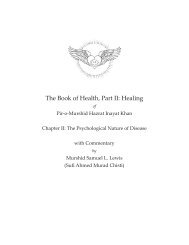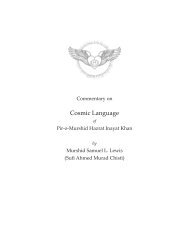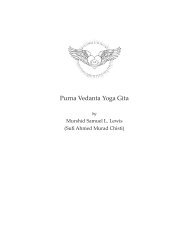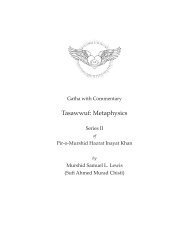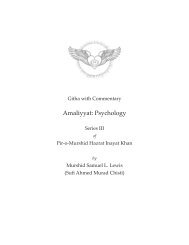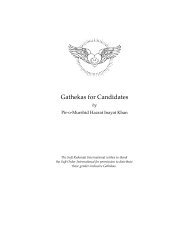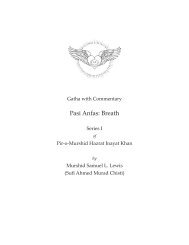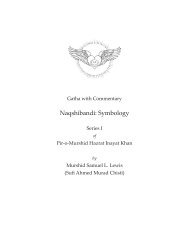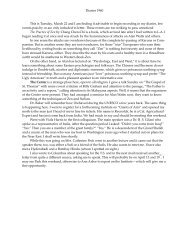Diary 1963 - Murshid Sam's Living Stream
Diary 1963 - Murshid Sam's Living Stream
Diary 1963 - Murshid Sam's Living Stream
You also want an ePaper? Increase the reach of your titles
YUMPU automatically turns print PDFs into web optimized ePapers that Google loves.
Diaries <strong>1963</strong>1088 Fulton StreetSan Francisco, 17, Calif.March 27, <strong>1963</strong>My Dear Saladin,When I was in Cleveland in 1930, I read The Lives of the Adepts by Efleki in French. It mademe very lonely indeed because these Sufi saints had had experiences to which my own were akinand there was nobody to talk to about them. It really pushed Rabia and I apart plus the fact that Idefeated her in a public examination—there were about 30 contestants. She never forgave me. It isonly now that a descendant of Jelal-ud-din Rumi has come here that I could really open up.In Pir-o-<strong>Murshid</strong>’s first constitution everything was to depend on spiritual development, buthe found that this could not work in the West. In Egypt they have open brotherhoods when there areno <strong>Murshid</strong>s and closed brotherhoods when they do, but all respect each other. This is determinedby experiences in fana-fi-lillah which is very definite.One of my closest friends in Pakistan is Professor A.A. Siddiqui, Punjabi University in Lahore.He has been afraid that because of my Western background I would introduce an unwelcome latidudarianism.The story becomes humorous:A. I told him that when I should become a Sufi <strong>Murshid</strong> I would restrict myself to the Azanand Fateha and not even use Qur’an, much less the traditions. This disarmed him.B. This was useless because in the meanwhile he became a Sufi disciple himself and was a littleperturbed that I was not a disciple of Pir Dewwal Shereef. But when I came to Lahore last we wereso much in agreement and I was already a Khalif, outranking him in his own school.In 1956 I spoke at the University on the Sufic interpretation of the Old and New Testamentsand in the comment he contrasted me against Maheboob, his sons and Vilayat, saying that they hadnot even touched the surface where I had plumbed the depths. Now I add to this that Hassan SaniNizami, son and successor of Hassan Nizami and therefore an important Pir-o-<strong>Murshid</strong>, considersme as the successor to Pir-o-<strong>Murshid</strong> Inayat Khan. He was with me when we visited the tombs of theFour Great Saints—Amir Khusrau, Nizam-ud-din Auliya, Inayat Khan and Hassan Nizami. If youwant details of what happened, I shall tell you. But the substance of my spiritual life can be summarizedin my relations to Nizam-ud-din Auliya and the events of Khilvat in Fairfax in 1925. The lasthave been practically rejected by almost every disciple of Inayat Khan and accepted totally by everyspiritual teacher whomsoever and wheresoever otherwise.In 1923 Pir-o-<strong>Murshid</strong> gave me a very long interview in which he outlined the need to contactthe intellectual people. He said in that private interview, and again in one of the gatherings of allmureeds that we must not appear exotic and must reach folks in their own language and habits. Thissent me on a very long intellectual journey, or many journeys into which we shall not go now.Just as in Pakistan I can teach all Sufism, God willing, from the Azan and Fateha, so in the WestI can teach all Sufism from the invocation and the Three Prayers–Saum, Salat, and Khatum. I havelong ceased to hope to convert any relative of Pir-o-<strong>Murshid</strong> to these prayers, but there is always thepossibility that one might accept them, just a little, on rare occasions. I am not fooling.



